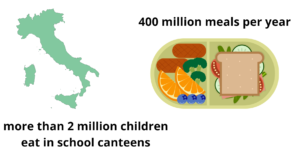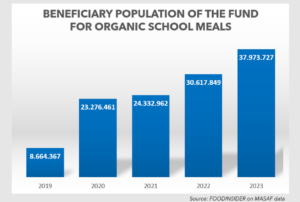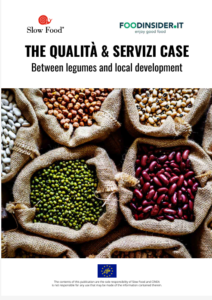SCHOOL CANTEENS IN ITALY

In Italy, the responsibility for the school canteen service is distributed among different ministries. The Ministry of Health sets nutritional guidelines for school catering, defining the meal standards. The canteen service tenders must now take into account the European Green Public Procurement (GPP) guidelines, which have been enforced in Italy through the Minimum Environmental Criteria Law (CAM). These criteria were established by the Ministry of Environment, Land and Sea Protection through a decree dated March 10, 2020. The CAM law governs the procurement processes for managing school canteen services across municipalities.
Additionally, in 2017, the Ministry of Agricultural, Food and Forestry Policies (Mipaaf) introduced a fund to support municipalities that offer high percentages of organic food in school meals. This fund aims to lower the costs of organic meals, promote educational initiatives within schools, and support meal services. The Ministry of Education supports food education in schools, although its efforts is not yet systematic.
THE METHOD OF ANALYSIS

The investigation on school menus spans several months and is divided into multiple steps: menu collection, data recording, data analysis, comparison with previous years’ data, data verification and consolidation and generation of the final report. Statistical processing and data analysis are presented in Chapter 3 of the report: “Results of the Investigation”.
In the initial phase, quantitative data are collected to assess the adherence of school menus to both health recommendations and to certain environmental sustainability criteria related to CAM. Data are collected by replying to the ‘points-based menu‘ questionnaire. A score is assigned to each answer (for example: ‘How many varieties of cereals are on the menu?’ or ‘How often is meat offered?’ or ‘How many foods are organic?’ or ‘How many foods are local?’). Subsequently, by contacting the municipalities under investigation, additional quantitative and qualitative data are collected. In the 2024 survey the focus is on the quality of bread and oil. Over the years, the dialogue with the administrations has fostered continuous exchange and has led, with the most cooperative municipalities, to the creation of a genuine platform for interaction and discussion.
To complete the picture and provide answers that cannot be obtained through the questionnaire (such as the appeal of the offered dishes, and the correspondence between what is indicated on the menu and what is actually present in the dishes), a specific survey has been conducted to investigate parents’ and teachers’ perception of service quality. The main issue that emerges from the teachers’ replies is that a high percentage of food remains uneaten and becomes waste.
THE ANALYSED PANEL
Over the years, the sample size of the survey has grown to currently include 60 winter menus from primary school catering in Italy, which represent approximately 30% of the meals served in elementary schools. In 2023, the analysed panel consisted of 26 municipalities in the North, 24 in the Central regions, and 9 in the South of Italy, considering that school meal services are much less widespread in the southern regions.
THE CONCLUSION OF THE LAST FOODINSIDER SURVEY (2024)
Foodinsider’s investigation reaffirms that the school canteen service is a key lever for promoting health, environmental sustainability, and community-based economic development. With the continued enforcement of the Minimum Environmental Criteria (CAM), school menus are showing progressive improvement. Since 2020, menus have become more diverse, including a greater variety of grains and legumes, more organic products, and an increased use of sustainable and locally sourced foods. Legumes are now often used as the main protein source, while whole grains and nuts are being introduced gradually, supported by educational programs. Nevertheless, processed foods and cold cuts are still present in many canteens, particularly where efficiency is prioritized over nutritional value.
The gap between high-quality and low-quality menus is widening. On one side are canteens that use food as an educational and community-building tool – offering local dishes, promoting zero-kilometer supply chains, using reusable dishware, and involving parents and teachers in food education. On the other side, some menus still rely heavily on red meat, canned tuna, and industrial desserts, often ignoring both sustainability standards and children’s food education needs.
Monitoring of food waste remains insufficient, and food consumption among children is declining. Teachers report that over 60% of students eat less than half of their meals, with major causes identified as lack of time, noise in dining spaces, and unappealing food. Initiatives such as food waste tracking and “reverse menu” models (serving less liked dishes first) offer potential solutions, but are not yet widespread.
The ranking clearly shows regional disparities: Northern municipalities dominate the excellence tier (Sesto Fiorentino, Parma, Cremona), while Southern Italy, despite some progress (notably in Puglia), still lags behind. These differences often reflect contrasting political and administrative approaches: canteens that “nourish” children and communities versus those that merely “feed.”
Ultimately, the CAM continues to be the most powerful driver of change, pushing municipalities toward more sustainable and inclusive school food systems. To bridge the quality gap, Foodinsider calls for stronger governance, adequate funding, and inclusive food policies that treat the school canteen not just as a service, but as a strategic tool for shaping healthier and fairer societies.
CHANGE IS POSSIBLE: THE BEST PRACTICE

Every year, in partnership with Slow Food, we study a school canteen best practice in Italy or Abroad. One of these studies analyzed the evolution of a public company, called Qualità & Servizi, providing school catering services in the province of Florence. In 2015, the Municipality of Sesto Fiorentino, supplied by Qualità & Servizi, ranked poorly on Foodinsider due to its predominant use of processed food. However, it is now in our Top 10, thanks to a transformation process that rigorously implemented the objectives of the Minimum Environmental Criteria (CAM).
You can read the study available also in English.

